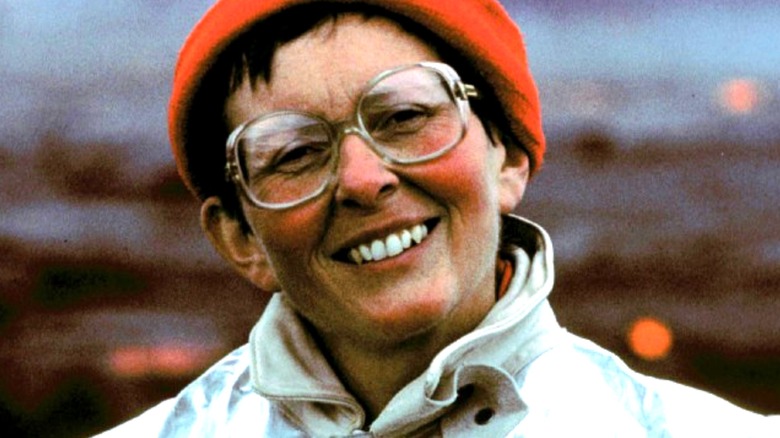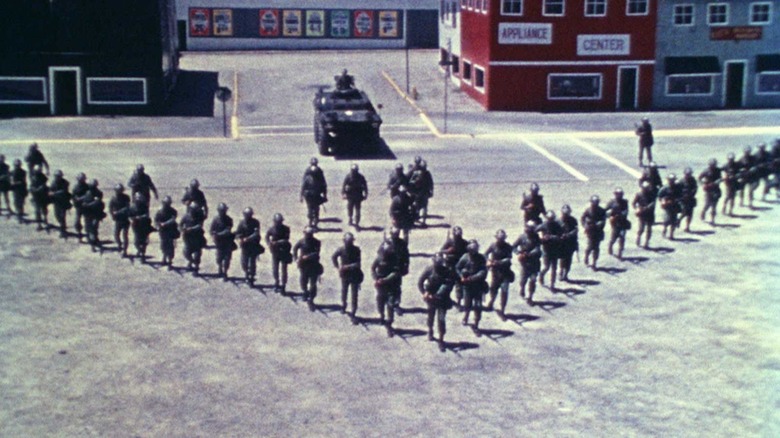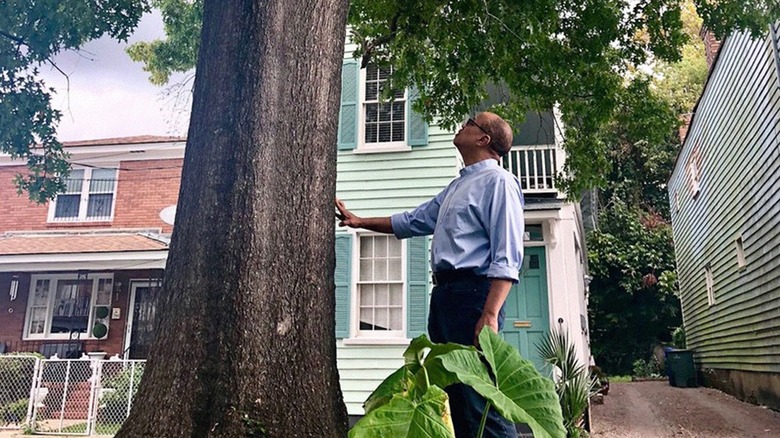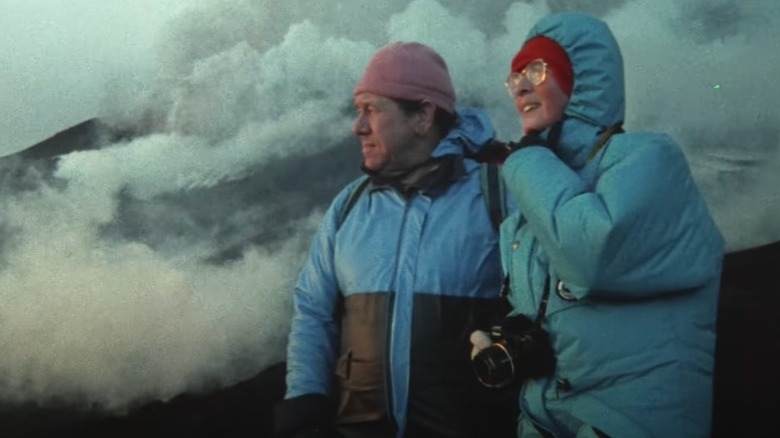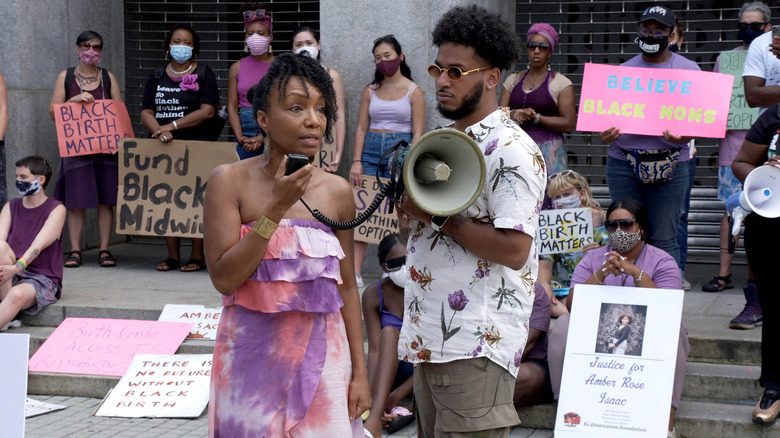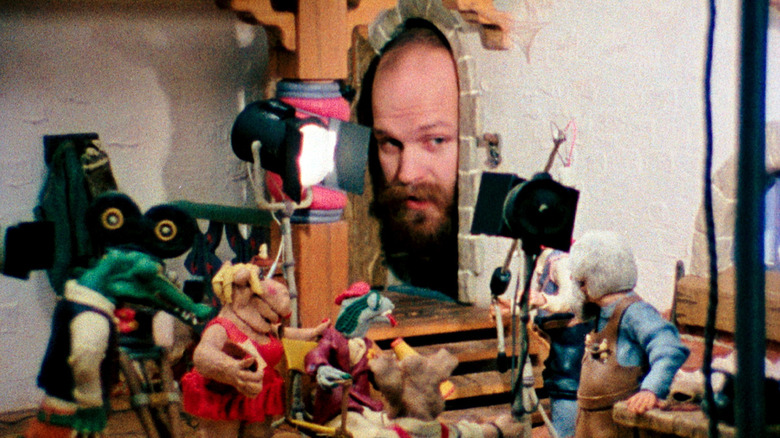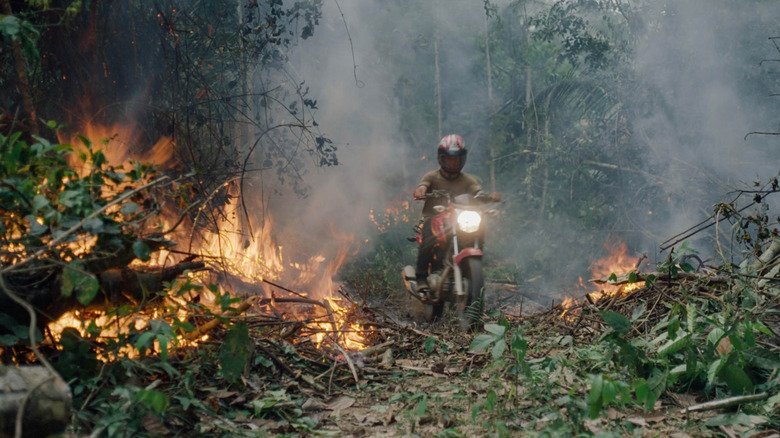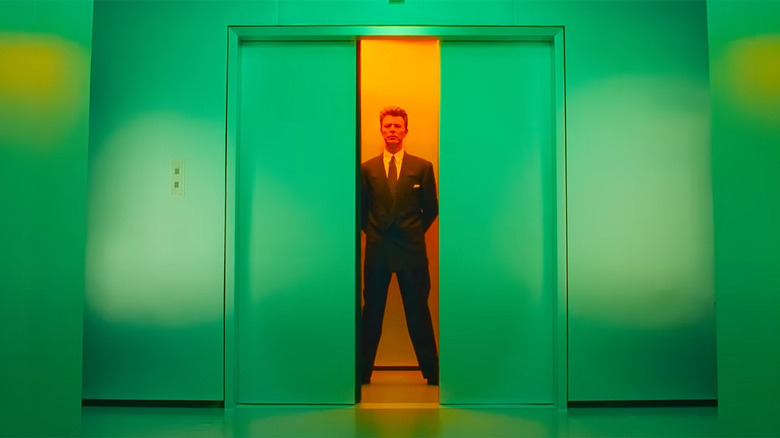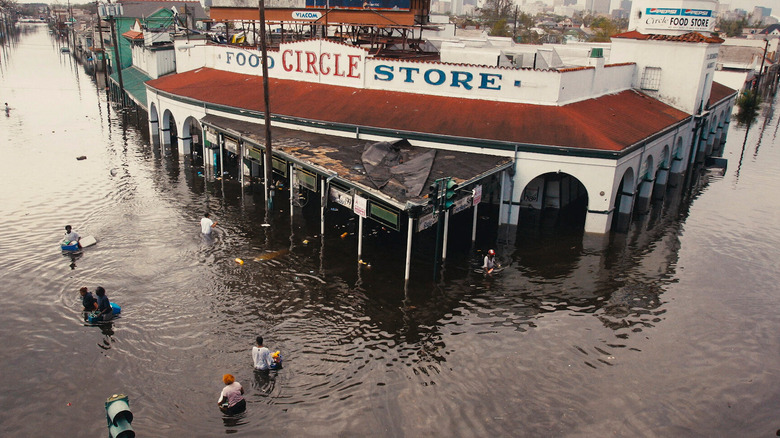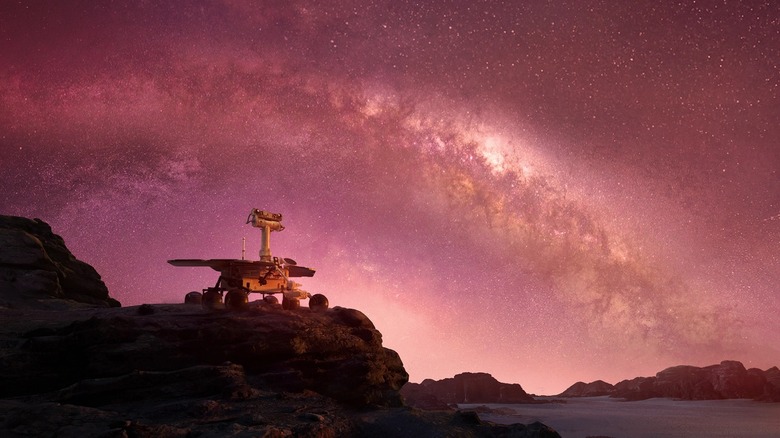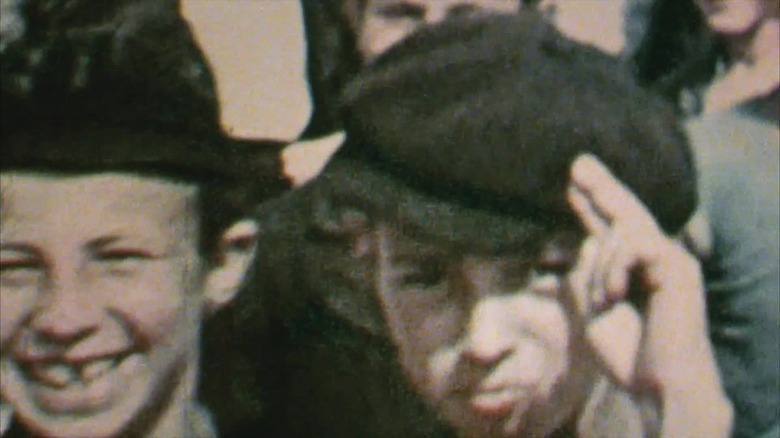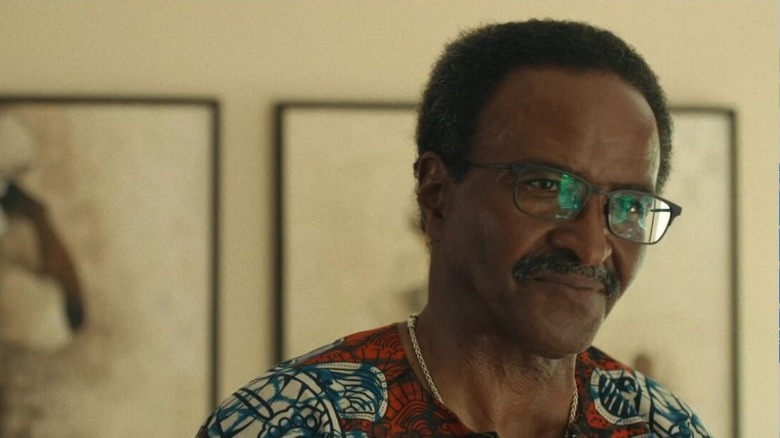The Best Documentaries Of 2022
It's no secret that 2022 has delivered some great movies that we'll all be talking about for years to come. What you might not know is that among those lastingly impactful titles are some under-seen documentaries, a medium that had a particularly fantastic year in 2022. The best documentaries of the year cover a wide array of heavy topics that mainstream narrative movies rarely acknowledge, let alone confront head-on. Even better, several of these projects are downright audacious in the way they fiddle with the form of cinema itself, breaking new ground for what documentary filmmaking can look and feel like. These aren't dry motion pictures designed to educate kids when the teacher doesn't feel like teaching. These are vibrant cinematic works that touch the heart and stimulate the brain.
When one looks back on noteworthy 2022 movies, there's no way documentaries like "Fire of Love," with its depiction of a romance as fiery as the hottest volcanoes, or "Bad Axe," with its chronicle of a family navigating modern-day white supremacy, will be forgotten. Taking a close look at the very best documentaries of 2022 and the qualities that make them so unforgettable will make one appreciate not just the films themselves, but the versatility of the documentary form. These films bring us closer to the world around us and let unheard voices speak louder than ever. For perfect proof of that, just look at the greatest documentaries released throughout 2022.
Riotsville, U.S.A.
One of the most incredible things about documentaries is their power to take previously-existing footage and recontextualize it to take on a whole new layer of meaning. Footage from older movies depicting racist or homophobic rhetoric, for instance, can be dropped into a documentary about the history of those issues in cinema and effectively amplify the harmfulness of those moments. Director Sierra Pettengill reaffirms this power with her feature "Riotsville, U.S.A.," which is named after a fake town created by the U.S. military where cops and soldiers could have space to practice subduing riots.
Archival footage is used throughout "Riotsville, U.S.A.," but among that imagery, the most interesting is old footage of officers simply training in the titular facility. This footage was previously kept behind locked doors and would've only been seen by powerful figures in the American military. But in the hands of Pettengill, images of cops and soldiers preparing to engage in racially discriminatory acts of violence are now unleashed on the public. The haunting images, accompanied by an unforgettable score by Jace Clayton, reflect how deeply ingrained systemic intolerance is in America. If this is how these "protectors of the peace" act on a fake town, Pettengill's work posits, imagine what they're doing to real-life protestors to this very day.
Who We Are: A Chronicle of Racism in America
ACLU deputy legal director Jeffery Robinson would like to talk to you. Specifically, he'd like to talk to you through his documentary "Who We Are: A Chronicle of Racism in America." Though undeniably straightforward in form, the film itself covers the topic of systemically-ingrained racial intolerance in America through a public speech given by Robinson. The result is appropriately expansive in scope and carries an inviting aura. Robinson keeps the deluge of information about how we got here as a country as digestible as possible, and walks that delicate public speaking tightrope of not being too dry but also not distracting from gravely important material with inappropriately lighthearted digressions. He's compelling on stage and drops some bombshells that may even make American history scholars raise an eyebrow in surprise.
Robinson also travels out into America for recurring segments in which he talks to various parts of the populace, including one man who still stands by the concept that the Confederacy was not at all about slavery. After this exchange, the camera lingers on Robinson on a bus being frustrated but also noting that he can't stop talking and trying to connect with even the most egregious of human beings. This response encapsulates the crux of "Who We Are: A Chronicle of Racism in America," a film that's cognizant of the horrific problems in America, while offering kernels of hope for the future.
Fire of Love
At the very start of "Fire of Love," narrator Miranda July calmly notes to the viewer that the central subjects of this movie, Katia and Maurice Krafft, will eventually perish at the hands of the very thing they're obsessed with: volcanoes. Before their untimely end, the duo was fixated on volcanoes and made this natural phenomenon their entire life. Bonding over shared interests is often said to be a great way to provide a bedrock for a romantic relationship, and the Kraffts are a great example of this. In the footage of the pair assembled by director Sara Dosa, the duo share a clear affection for each other even as they navigate risky and outright hostile landscapes to pursue their precious volcanoes.
Speaking of volcanoes, the various pieces of footage — predominately captured by Katia and Marice Krafft or their camera crew — of volcanoes up close are extraordinary, and are enough on their own to make "Fire of Love" worth seeing. You can practically feel the heat radiate off the screen as lava comes dangerously close to our two lead characters. If you've ever wanted to watch a movie where a man fries an egg on the hot surface of a volcano, then "Fire of Love" is for you. The fact that it comes with a genuinely sweet romance is just a bonus.
Aftershock
Shamony Gibson and Amber Rose Isaac were two vastly different human beings who shared one key trait: they both died during childbirth. These tragedies are not an anomaly, but, as chronicled by directors Paula Eiselt and Tonya Lewis Lee in "Aftershock," are emblematic of a larger problem in the U.S. health system that disproportionately affects Black women. With no immediate hope in sight for these and countless other deaths, a grassroots effort has begun to emerge to enact change. The images of people protesting and calling for action in "Aftershock" are undeniably stirring, as are testimonies from those who have lost loved ones to childbirth complications.
"Aftershock" puts a human face on despair happening in one's own backyard, while the scope of Eiselt and Lee's filmmaking makes sure to quietly remind the viewer that these kinds of deaths can happen anywhere. Even in the most affluent of places, America's disinterest in seeing Black women as human beings can fester and have devastating consequences. Combining this with the restrained filmmaking in the interview segments gives "Aftershock" room to leave an unspeakable impact on the viewer. It's a documentary that offers a harrowing glimpse into the here and now.
Claydream
The world of stop-motion animation is home to many recognizable figures, from Aardman's Nick Park to "Nightmare Before Christmas" director Henry Selick. Will Vinton's name and face may not be instantly familiar to every fan of this time-consuming medium, but he's left behind an enormous legacy for future stop-motion projects to live up to. The late animation legend is the central subject of "Claydream," a documentary chronicling the history of Vinton and his outfit Will Vinton Productions. Vinton aimed to be the Walt Disney of American stop-motion animation, and "Claydream" paints a vivid picture of how much passion and ambition he had for his craft.
Unfortunately, "Claydream" also demonstrates the endless sea of problems Vinton's creativity faced in getting seen by mainstream audiences, or even existing in American pop culture. There's an undeniably tragic quality to this documentary as one is left wondering what else Will Vinton Productions could've accomplished if it had the resources to make more movies like "The Adventures of Mark Twain." The warts-and-all approach to the history of Vinton's artistic forays, not to mention the compelling aura of the man himself, makes "Claydream" something you can't turn away from. By the time the credits roll and we witness Vinton's company getting taken over and turned into Laika, any proper animation geek will be heralding Vinton as an unsung legend.
The Territory
There are many wonderful sights within the Amazon rainforest, which is home to the Uru-eu-wau-wau people. The members of this indigenous tribe carry out their days taking care of each other, making food, and unfortunately, having to protect their own land. People are constantly trying to intrude on their turf and the surrounding rainforest area in the name of commerce. Director Alex Pritz chronicles in "The Territory" the struggles of the Uru-eu-wau-wau, but the film also focuses its lens on other larger issues informing the constant destruction of the beautiful Amazon. Specifically, Pritz highlights how many of the people cutting into the forest say they need the money that comes from this destruction, and there's an emphasis on how much of this entire conflict comes from former Brazil president Jair Bolsonaro pitting members of lower-economic classes against one another. Capitalism is the unseen enemy looming in the shadows and informing the suppression of indigenous lives.
"The Territory" isn't just all about indigenous suffering 24/7, though. One of the most striking sequences of the entire film comes from Bitaté, a member of the Ure-eu-wau-wau, getting ahold of the camera and filming things from his own perspective. There's such vibrant humanity in these segments, not to mention glorious subversion in seeing an indigenous lens on documentary filmmaking, a genre largely built on dehumanizing this population with movies like "Nanook of the North."
Moonage Daydream
Who is David Bowie? On the surface, that's an easy question to answer. He was a popular musician whose unorthodox stage personas became beloved by social outcasts everywhere. But dig deeper here and ponder the question of who David Bowie was as a person in his most intimate moments. Answers may evade you in contemplating that query, and you won't find easy answers to who David Bowie truly was in the documentary "Moonage Daydream." However, this project, assembled by director Brett Morgen from pre-existing footage of Bowie (much of it captured by the musician himself) provides an in-depth glimpse into the many corners of Bowie's psyche and the various places his ambitions stretched to during his life. Even if you don't get a concise image of Bowie as a single person, "Moonage Daydream" offers fleeting and gorgeously-realized visions of the various facets of this iconic artist.
In the process, the documentary makes a moving case for Bowie being too complicated a person to ever be boiled down to just a sentence. He's someone whose depths deserve more nuance and unique exploration, qualities apparent throughout "Moonage Daydream." The movie often plays like an unpredictable dream rather than a standard musician biopic, particularly when it uses abstract images and colors to represent aspects of Bowie's tunes. We'll never fully know who David Bowie was as a person, but "Moonage Daydream" still makes spending time inside his mind a fascinating experience.
Katrina Babies
For many of us, our only experience with Hurricane Katrina, which devastated New Orleans in 2005, was seeing footage of all the destruction and emotional turmoil during TV news reports. These broadcasts conveyed basic information about the hurricane, but they could never really get to the beating heart of what was going on with the people affected by this overwhelming natural disaster. Director Edward Bucklers Jr., himself somebody who was just a child when Katrina hit, uses the documentary "Katrina Babies" to interview a wide assortment of people who were under the age of 18 when a hurricane wiped out everything they'd ever known. The lingering psychological impact of that kind of event doesn't go away, and "Katrina Babies" is an opportunity for these human beings to be vulnerable and open about how Katrina shaped their lives.
The interview segments of "Katrina Babies" are often harrowing, and vary wildly in the moments they recount. There isn't one singular experience in surviving a hurricane, as seen by the testimonies of each of the people Bucklers Jr. interviews. Pain isn't the only thing that the camera captures, though, as the vibrant spirit of community and endurance within New Orleans also radiates off the screen. "Katrina Babies" takes viewers through a vast spectrum of emotions, all to humanize hurricane survivors who've often had their voices erased.
Good Night Oppy
Going to Mars is usually the domain of science-fiction narrative films, but a real journey to the red planet is the entire basis for "Good Night Oppy," a documentary chronicling a pair of rovers, named Spirit and Opportunity, sent to Mars. These unmanned devices were able to send pictures back to NASA officials through space, and helped to further knowledge about this other world. Impressively, Opportunity managed to survive on the surface of Mars for well over a decade. The odds were impossible, but this piece of hardware kept defying expectations and changing the game for how human beings understood Mars.
The weight of these achievements is fully felt throughout "Good Night Oppy," partially thanks to incredibly well-realized sequences that utilize lifelike CGI to recreate scenarios the Opportunity rover encountered on Mars. The transitions between these segments and interviews with the flesh-and-blood humans at NASA are utterly seamless. Those latter interviews are an incredibly important part of "Good Night Oppy," too, and help to put a human face on extraordinary technological achievements. That vibrant sense of humanity makes anecdotes that could've sounded ridiculous in other contexts – like the story of how the crew back on Earth wanted Opportunity to take a selfie in its final weeks of operation — utterly heartwarming here.
Three Minutes - A Lengthening
"Three Minutes – A Lengthening" begins with three minutes of footage captured in a small town in Poland in 1938. There doesn't seem to be much to the footage, but after it plays once, director Bianca Stigter begins to dig deeper. Glenn Kurtz, the man who found this footage which was captured by his grandfather decades earlier, offers up narration explaining how he began the process of tracking down the name of the town where this was shot and who lived there. You see, this footage was captured in a largely Jewish town, and nearly all of its inhabitants would perish in the next few years in the genocide of the Nazis. This brief footage is not just a vintage vacation video — it's a glimpse into lives lost to history.
Stigter opts to keep the focus of the camera almost exclusively on images and frames seen in the three minutes of recovered footage. We never cut away to in-person interviews, even when they involve words spoken by narrator Helena Bonham Carter. Instead, the filmmaker boldly keeps the focus on these human beings from 1938 while anecdotes (told in voice-over) from the few survivors of the town underscore the humanity of those in the frame. "Three Minutes – A Lengthening" is an ode to souls long gone and the power of cinema to preserve human beings in the most unexpected of ways.
Descendant
The Clotilda was the last ship that transported enslaved Africans to the United States of America, making its final journey more than 50 years after the importing of slaves was declared illegal. Afterward, it was sunk in an initially unknown location so that the people behind this endeavor would never face justice for their crimes. "Descendant" picks up in the modern world in Africatown, a tiny community in Alabama containing many inhabitants who are direct descendants of people forcibly brought to America on the Clotilda. Director Margaret Brown interviews countless individuals throughout "Descendant" to hear varying perspectives on how the search for the missing Clotilda should be handled in the 21st century. The gaze of her camera eventually expands outward enough to reflect how the dehumanization of Black people in this area is not confined just to the 19th century. Environmental issues and looming big businesses are severely and adversely impacting the population of Africatown.
The past, the present, and the future are all deeply intertwined in many ways, and that's especially true of the subject matter and the human beings captured on film by "Descendant." Brown effectively captures the wide scope of the impact that the Clotilda and systemic racism have had on this community, without losing sight of the human lives in play. The result is a striking piece of documentary filmmaking that goes far deeper than just pondering what happened to a missing slave ship.
Bad Axe
When the COVID-19 pandemic hit, nobody knew exactly what to do. This was an entirely unprecedented scenario, and there was no handbook around to help provide clarity of where to go next. For director David Siev, his plan was to return to his rural hometown in Michigan, where his family runs a restaurant. Here, he began to film his family's exploits as they tried to keep an eating establishment going during the unpredictable chaos of 2020. As the year continued, his documentary, entitled "Bad Axe," turned into so much more than that. As further events like Black Lives Matter protests and an increase in visible white supremacy began to dominate the year, "Bad Axe" also became about his family of Cambodian Americans just trying to survive.
"Bad Axe" juggles a lot in just 100 minutes, including how Siev's father, Chun Siev, has had his psychological outlook informed by his childhood experiences in the Cambodian Genocide. However, using the Siev family as a constant throughout all these detours and developments makes the whole feature feel cohesive, while the deluge of storylines feels quite authentic to how the year 2020 was hitting people with everything and the kitchen sink. Best of all, Siev's camera captures a family that shares a far-from-perfect dynamic, but that's also what makes them feel like an authentic family. This realistic and endlessly moving depiction of familial bonds in times of hardship makes "Bad Axe" a feature you can't turn away from.
